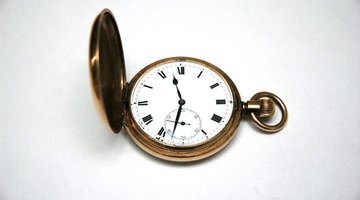How to Adjust Pocket Watches
The first pocket watches were seen in Europe in the 15th Century and were the most common types of watch from the 16th Century until after World War I, when wristwatches began to gain popularity. Pocket watches were usually carried in a waistcoat pocket and would often be attached to a safety chain, which was anchored into a buttonhole. If you have a pocket watch that needs the time adjusted or that consistently gains or loses time, you will need to adjust it.
Adjusting the Time

-
At the top of your pocket watch, you should see a small thumbscrew. This is attached to a spindle that is itself attached to the watch's hands.
-
Pull the thumbscrew outward, away from the watch, until it is fully out. If your pocket watch has a display, there may be an intermediate position to change the date.
-
Change the hour and minute hands by turning this knob until the correct time is displayed.
-
Push the thumbscrew down until it is firmly in position. The time has now been adjusted.
Adjusting the Watch's Speed
-
The speed at which a watch runs is governed by the regulator, a device that incorporates a hairspring that usually has about 12 coils that oscillates back and forth. Altering the regulator lengthens or shortens the effective length of the hairspring, which in turn alters the period of the swing. Set the watch's time as in Section 1, and note the exact time against that of a quartz or digital watch. Set the pocket watch aside for 24 hours.
-
After 24 hours, check the time of both watches and make a note of how much time the pocket watch has gained or lost over 24 hours.
-
Open up the rear of the pocket watch. On some old pocket watches, it can be lifted with a mini screwdriver; in others, it must be screwed off.
-
Using a jeweler's loupe, locate regulator with its hairspring. This will be the small ring that is rotating back and forth. You should see a pointer located next to hash marks with an "S" to one side and a "F" to the other.
-
Using a pin, move the pointer towards the "S" to slow down the watch's speed or towards the "F" to make the watch go faster.
-
Repeat steps 1 and 2, and, if necessary, steps 3 through 5 until the watch is neither gaining nor losing time against the quartz or digital watch. The regulator of the pocket watch has now been adjusted.
References
Tips
- In some watches, there is a tiny screw below the regulator's pointer that can be adjusted with a mini screwdriver rather than physically moving the pointer.
Writer Bio
Michael Mason started content writing in 2006. He has had articles published on Yachting.com, Biking.com and Skiers.com. He was educated at Bromsgrove School in England and at Britannia Royal Naval College, Dartmouth, England, where he graduated as a naval officer and majored in air warfare and navigation. He is a retired naval aviator.
Photo Credits
- gold pocket watch image by Warren Millar from Fotolia.com
More Articles



